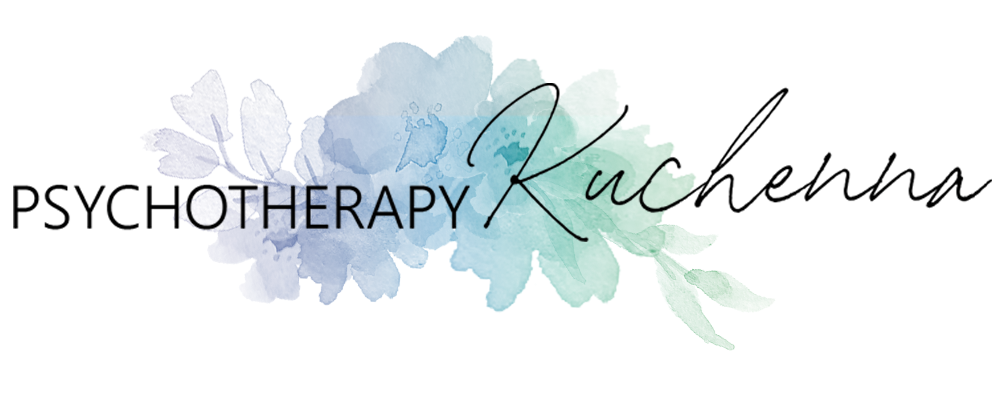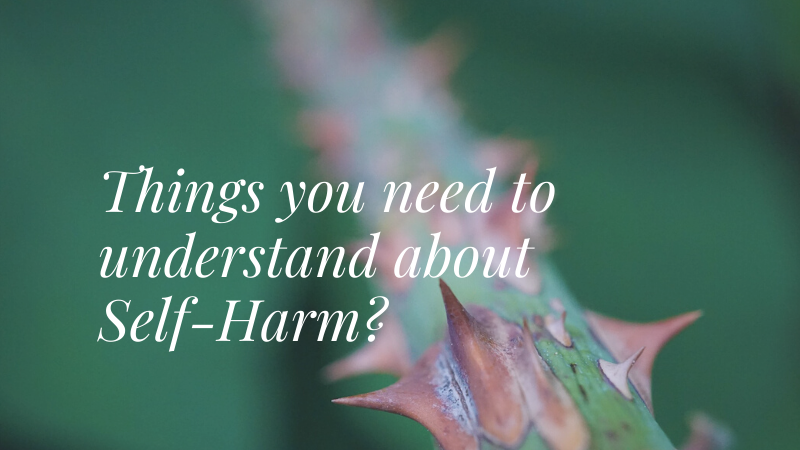WHAT IS SELF-HARM?
Self-harm is when someone deliberately hurts, cuts, or injures themselves. For some people, self-harm is a way of coping with difficult or overwhelming feelings.
Many people self- harm as a coping mechanism to deal with intense or difficult emotions. You might not know why you or someone else self-harms but that’s ok. You can work with a mental health professional like a psychotherapist who can help you figure that out.
Self-harm can be a way of dealing with deep distress and emotional pain. It may help you express feelings you can’t put into words, distract you from your life, or release emotional pain. Afterward, you probably feel better – at least for a little while. But then the painful feelings return, and you feel the urge to hurt yourself again.
People may self-harm to:
- Express overwhelming emotional distress.
- Express difficult feelings.
- Feel in control of their lives.
- Cope with feelings like sadness, self-loathing, emptiness, guilt, and rage.
- Express feelings they can’t put into words or release the pain and tension they feel inside.
- Feel in control, relieve guilt or punishment.
- Distract themselves from overwhelming emotions or difficult life circumstances.
- Make them feel alive, or simply feel something, instead of feeling numb.
MENTAL HEALTH AND SELF- HARM
Self-harm often is linked to anxiety and depression. These mental health conditions can affect people of any age. But we need to remember that self- harm is a distinct issue from suicide. People who self-harm don’t want to die, they are trying to cope with their distress and emotions. Self-harm and suicide are two different components.
In many cases, people who self-harm do it to help them cope with overwhelming emotional pain. However, this could be caused by social problems, trauma, or psychological reasons.
Social problems:
- being bullied
- having difficulties at work or school
- having difficult relationships with friends or family
- coming to terms with sexuality
- coping with expectations
Trauma:
- physical or sexual abuse
- death of a close family member or friend
- having a miscarriage
Psychological causes:
- having repeated thoughts or voices telling them to self-harm
- disassociating – losing touch with who they are and with their surroundings
- borderline personality disorder
TYPES OF SELF-HARM
There are many different ways people can intentionally harm themselves, such as:
- cutting or burning their skin
- punching or hitting themselves
- poisoning themselves with tablets or toxic chemicals
- misusing alcohol or drugs
- deliberately starving themselves (anorexia nervosa) or binge eating (bulimia nervosa)
- excessively exercising
People often try to keep self-harm a secret because of shame or fear of it being seen. They may cover up their skin and avoid discussing the problem.
It’s often up to close family and friends to notice when somebody is self-harming. They should approach the subject with care and understanding and without judgment!
SIGNS OF SELF-HARM
If you think a friend or relative is self-harming, look out for signs, including:
- unexplained cuts, bruises or cigarette burns – usually on the wrists, arms, thighs, and chest
- keeping themselves fully covered at all times, even in hot weather
- pulling out their hair
- alcohol or drugs misuse
- self-loathing and expressing a wish to punish themselves
- speaking about not wanting to go on and wishing to end it all
- becoming very withdrawn and not speaking to others
- changes in eating habits or being secretive about eating
- unusual weight loss or weight gain
- signs of low self-esteem, such as blaming themselves for any problems or thinking they’re not good enough for something
- signs of depression, such as low mood, tearfulness or a lack of motivation or interest in anything
Moreover, self-harm can also include less obvious ways of hurting yourself or putting yourself in danger, such as driving recklessly, binge drinking, taking too many drugs, or having unsafe sex.
WHY DO PEOPLE SELF-HARM?
Self- harm is often used to relieve tension or anger. It might also be a way to let out feelings and to deal with sadness, stress, self-hatred, or depression. Many people self -harm as a coping mechanism to deal with intense and difficult emotions. These feelings are often pushed down and eventually are expressed by causing physical pain.
Here are some more reasons why a person might self- harm:
- Some people find it easier to cope with physical pain rather than emotional pain.
- Some people find that self -harming relieves anxiety and tension and helps calm them down when they are distressed.
- Physical injuries are often easier to cope with than the invisible emotional pain.
- Not being able to express your feelings by crying, or as a way of communicating distress to yourself or others when you don’t have the right words.
- Physical hurt takes your mind away from emotional pain.
- Self- harm may help you deal with past trauma, such as sexual assault, rape, or abuse.
- You may feel happy with your current life now, but feel the need to self -harm when you think about past traumas.
- To deal with anger. Some people are very uncomfortable expressing anger outwardly. So they turn this anger on themselves and self -harm instead.
- Hating yourself and hurting your body in punishment.
- To help calm yourself. Some people find that self –harm is helpful in calming down the emotions.
CONSEQUENCES OF SELF-HARM
The relief that comes from cutting or self-harming is only temporary and creates far more problems than it solves. Let’s look at the potential consequences of self-harm.
- Relief from cutting or self-harm is short lived, and is quickly followed by other feelings like shame and guilt. Meanwhile, it keeps you from learning more effective strategies for feeling better.
- Keeping the secret of self-harm is difficult and lonely. Maybe you feel ashamed or maybe you just think that no one would understand. But hiding who you are and what you feel is a heavy burden. Ultimately, the secrecy and guilt affects your relationships with friends and family members and how you feel about yourself.
- You can hurt yourself badly, even if you don’t mean to. It’s easy to end up with an infected wound or misjudge the depth of a cut, especially if you’re also using drugs or alcohol.
- You’re at risk for bigger problems down the line. If you don’t learn other ways to deal with emotional pain, you increase your risk of major depression, drug and alcohol addiction, and suicide.
- Self-harm can become addictive. It may start off as an impulse or something you do to feel more in control, but soon it feels like the cutting or self-harming is controlling you. It often turns into a compulsive behaviour that seems impossible to stop.
The bottom line is that cutting and self-harm won’t help you with the issues that made you want to hurt yourself in the first place. No matter how lonely, worthless, or trapped you may be feeling right now, there are many other, more effective ways to overcome the underlying issues that drive your self-harm.
ALTERNATIVE WAYS OF COPING
Self-harm is your way of dealing with unpleasant feelings and difficult situations. If you’re going to stop, you need to have alternative ways of coping so you can respond differently when you feel like cutting or hurting yourself.
If you self-harm to express pain and intense emotions, you could:
- Paint, draw, or scribble on a big piece of paper with red ink or paint
- Start a journal in which to express your feelings
- Compose a poem or song to say what you feel
- Write down any negative feelings and then rip the paper up
- Listen to music that expresses what you’re feeling
If you self-harm to calm and soothe yourself, you could:
- Take a bath or hot shower
- Pet or cuddle with a dog or cat
- Wrap yourself in a warm blanket
- Massage your neck, hands, and feet
- Listen to calming music
If you self-harm because you feel disconnected or numb, you could:
- Call a friend (you don’t have to talk about self-harm)
- Take a cold shower
- Hold an ice cube in the crook of your arm or leg
- Chew something with a very strong taste, like chili peppers, peppermint, or a grapefruit peel
- Go online to a self-help website, chat room, or message board
If you self-harm to release tension or vent anger, you could:
- Exercise vigorously—run, dance, jump rope, or hit a punching bag
- Punch a cushion or mattress or scream into your pillow
- Squeeze a stress ball or squish Play-Doh or clay
- Rip something up (sheets of paper, a magazine)
- Make some noise (play an instrument, bang on pots and pans)
PROFESSIONAL TREATMENT FOR CUTTING AND SELF-HARM
The help and support of a trained professional can help you work to overcome the cutting or self-harming habit, so consider talking to a therapist. A psychotherapist can help you develop new coping techniques and strategies to stop self-harming, while also helping you get to the root of why you hurt yourself.
Remember, self-harm doesn’t occur in a vacuum. It exists in real life. It’s an outward expression of inner pain-pain that often has its roots in early life. However, there is often a connection between self-harm and childhood trauma. Self-harm may be your way of coping with feelings related to past abuse, flashbacks, negative feelings about your body, or other traumatic memories-even if you’re not consciously aware of the connection.

